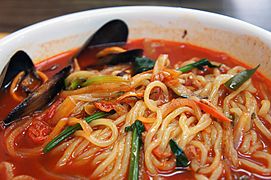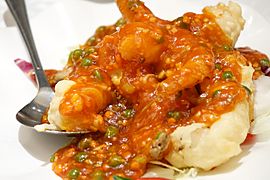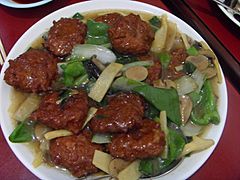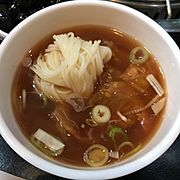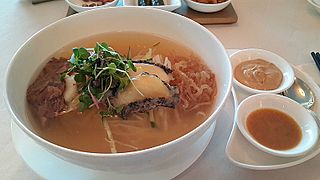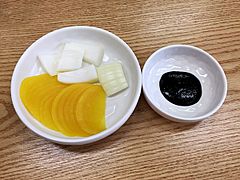Korean Chinese cuisine facts for kids
| Korean Chinese cuisine | |

|
|
Quick facts for kids Korean name |
|
|---|---|
| Hangul |
중화 요리
|
| Hanja |
[韓國式]中華料理
|
| Revised Romanization | junghwa yori |
| McCune–Reischauer | chunghwa yori |
| IPA | [tɕuŋ.hwa jo.ɾi] |
Korean–Chinese cuisine (Korean: 중화 요리; Hanja: 中華料理; RR: junghwa yori), also called Sino–Korean cuisine, is a special type of food. It was created by Chinese people living in Korea.
Even though it started from Chinese cooking, Korean-Chinese cuisine has its own unique dishes. These dishes use Korean flavors and ingredients. This is why it's called a "hybrid" cuisine, meaning it's a mix of two styles.
In South Korea, these foods are often delivered right to your door. In other parts of the world, you can usually find Korean-Chinese dishes in Korean restaurants. You might also find them in Chinese restaurants owned by people from Korea or by Chinese-Korean families.
Contents
How Did Korean-Chinese Food Start?
Korean-Chinese cuisine first began in the 1800s. This happened in the port city of Incheon. Many Chinese immigrants lived there at the time.
Most of these early Chinese immigrants came from the Shandong area of China. Because of this, most Korean-Chinese dishes are similar to or influenced by foods from northern, eastern, and northeastern China.
What Are the Main Korean-Chinese Dishes?
There are three main Korean-Chinese dishes that you will find in most restaurants. These are very popular in South Korea and around the world.
- Jajangmyeon (짜장면) is a noodle dish. It comes with a thick, dark sauce. This sauce is made from a sweet black bean paste called chunjang. It also has diced pork or seafood, and vegetables. This dish came from the Chinese zhájiàngmiàn (炸酱面). But the Korean jajangmyeon has its own special taste.
- Jjamppong (짬뽕) is a spicy noodle soup. It gets its flavor from vegetables, meat or seafood, and chili oil. This soup came from the Chinese chǎomǎmiàn (炒码面). Its name comes from chanpon, a Japanese Chinese dish. People started adding chili powder (gochugaru) and chili oil to jjamppong in the 1960s. This made it spicy!
- Tangsuyuk (탕수육) is the Korean version of a sweet and sour meat dish. It came from the Chinese tángcùròu (糖醋肉). It can be made with pork or beef. The meat is coated in cornstarch, potato starch, or glutinous rice flour and then fried. It is served with a sweet-and-sour sauce. This sauce often has soy sauce, vinegar, sugar, and fruits and vegetables like carrots, pineapples, and mushrooms.
Other Popular Dishes
Many other tasty dishes are also served in Korean-Chinese restaurants:
- Jungguk-naengmyeon (중국냉면), which means "Chinese cold noodles," is a refreshing dish. People enjoy it especially in the summer. It has Chinese noodles, shredded five-spice marinated beef or pork, cucumber, crab sticks, jellyfish, and a fried egg. All of this is in a cold chicken broth. A sauce with mustard and peanut butter gives it a nutty, spicy flavor.
- Kkanpunggi (깐풍기) is fried chicken. It can be with or without bones. It's covered in a sweet and spicy sauce.
- Kkanpung saeu (Korean: 깐풍새우) is deep-fried, breaded sweet-and-sour shrimp. It has a mild spicy taste. It's served with a sweet sauce, peas, carrots, green onions, and red chili peppers.
- Udong (우동) is a noodle soup. It's like jjamppong but has a non-spicy white soup. This dish is not related to Japanese udon or Korean-style udong, even though they share a similar name.
- Ulmyeon (Korean: 울면) is another noodle dish. It has noodles, chopped vegetables, and seafood. These are in a thick, chowder-like broth, made thick with cornstarch.
Side Dishes and Snacks
Dumplings are also common in Korean-Chinese restaurants. They are usually pan-fried and are a mix between Chinese jiaozi and Korean mandu. You can add dried red-chili flakes to your food or mix them with soy sauce for extra flavor.
When Koreans eat Chinese food, they often have side dishes. These include danmuji (yellow pickled radishes) and raw onion dipped in unfried chunjang (the black bean sauce). Kimchi, a famous Korean side dish, is also eaten with Chinese food.
Hotteok is a Korean-Chinese food item that is now a popular street food. It's a sweet pancake often filled with brown sugar syrup.
Gallery
-
Gun-mandu (pan-fried dumplings)
-
Jajangmyeon (black sauce noodles)
-
Jjamppong (spicy seafood noodle soup)
-
Kkansyo-saeu (chili shrimp)
-
Menbosya (shrimp toast)
-
Nurungji-tang (scorched rice soup)
-
Ohyang-jangyuk (steamed five spice pork slices)
-
Tangsuyuk (sweet and sour pork)
-
Jungguk-naengmyeon (Chinese cold noodle soup)
-
Palbochae (eight treasure dish)
See also
 In Spanish: Gastronomía sino-coreana para niños
In Spanish: Gastronomía sino-coreana para niños





